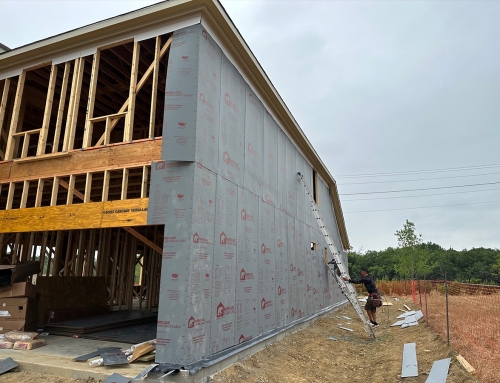House wrap and felt paper, when properly installed and undamaged, are both weather resistant barriers (WRB) that create permeable and water- and air-resistant exterior walls. The main advantage of house wrap, over felt paper, is the superior strength and durability of house wrap.
A high-quality house wrap, like Barricade® Building Wrap, is more resistant to ripping and tearing during installation than felt paper. The integrity of house wrap ensures its performance in resisting air and moisture and makes it the better choice for a weather resistant barrier over felt paper.
What is a Weather Resistant Barrier?
House wrap and asphalt felt paper are WRBs that serve as the second line of protection against moisture and air entering a home or building. The wall cladding is the initial line of protection. The American Architectural Manufacturers Association (AAMA) defines a weather-resistant barrier as a surface or a wall responsible for preventing water and air infiltration to the structure’s interior.
Importantly, a weather-resistant barrier must meet the 2018 International Building Codes (IBC 1402.2) requirements for water-resistance and vapor permeability, along with the 2018 International Residential Code for water resistance (IRC R703.1.1).
Why Apply a Weather Resistant Barrier to a Home or Commercial Building
Weather resistant barriers prevent the accumulation of moisture in a wall system. During a rain or wind event, moisture moves around, on, and through the porous materials of a building (like stained wood clapboards and unfinished shingles). Also, because the air pressure inside a structure typically is lower than outside the structure, the pressure difference works to pull the water in through any defect in the exterior wall it finds; butt-joints, seams, holes, siding overlaps, etc.
Moisture in a wall system can cause structural problems, mold, and diminished indoor environmental quality. A WRB is essential to stopping and removing the accumulation of moisture in the wall cavity.
Weather-resistant barriers are not water-resistant barriers. Water-resistant barriers produce only a continuous water-resistant barrier behind the exterior wall veneer. A high-quality WRB is air- and moisture-resistant, permeable, and has high tear strength and UV-resistance. It should also be simple to install.
House wrap and asphalt felt paper are weather-resistant barriers that strive to achieve energy-efficient, healthy, and comfortable homes or commercial buildings.
Asphalt Felt Paper as a Weather-Resistant Barrier
Manufacturing of asphalt felt began over a hundred years ago. Initially, cloth felt, which came from recycled cotton rags, was used to make asphalt felt. Today, asphalt felt is made from a mixture of sawdust and recycled corrugated paper. In the beginning, 15-pound asphalt felt weighed 15 pounds per 100 square feet. However, to lower production costs, manufacturers began lowering the weight.
Today, the number 15 asphalt felt (Type 1) weighs between seven and fourteen pounds per 100 square feet. The number 30 felt (Type 2) weighs 16.5 or 17 pounds. Importantly, the ASTM has two standards for asphalt felt. The ASTM D 4869, requires number 15 felt to weigh at least 8 pounds per 100 square feet.
The more strict standard, ASTM D 226, requires a minimum weight of 11.5 pounds per square. However, the 2018 IBC Section 1403.2 and the 2018 IRC Section R703.2 requires Type 1 asphalt felt, in compliance with ASTM D 226, when the asphalt felt is used as a continuous water-resistive barrier behind the exterior wall veneer.
The Benefits of Asphalt Felt Paper
A benefit of asphalt felt paper is its ability to absorb water, and then slowly evaporate the moisture to the exterior. Dry asphalt felt’s permeance is 5 perms. But, when wet, asphalt felt’s permeance is 60 perms. So, if water gets behind the asphalt felt, due to a leak or condensation, the felt will soak up the liquid water. Due to asphalt felt’s high permanence, the absorbed water will gradually dry to the exterior of the building.
The Disadvantages of Asphalt Felt Paper
There are several important drawbacks to using asphalt felt paper as a weather-resistive barrier. Asphalt felt will tear if not handled carefully. It also tends to get brittle and deteriorate if left exposed to sunlight for long periods of time. Tears, rips, and cuts in the asphalt felt paper diminish its performance as a WRB by allowing air and moisture to enter the wall assembly.
High-Quality House Wrap as a Weather Resistant Barrier
House wrap is a lightweight and synthetic material that goes over the sheathing and behind the siding. An essential feature of house wrap is its microscopic pores that allow water vapor to pass through; however, the pores are too tiny for bulk water and air. Without these microscopic pores, moisture would build up in the wall system.
Importantly, a high-quality house wrap, like Barricade® Building Wrap, has excellent strength and durability to minimize damage from outside elements (sun, wind, rain) or rough handling during the installation process. A high-quality house wrap is water- and air-resistant. It also provides drainage, UV inhibitors, tear strength, temperature resistance, and vapor permeability.
House Wrap Vs. Asphalt Felt Paper
Selecting a high-quality house wrap, like Barricade® Building Wrap, over asphalt felt paper, ensures a WRB with superior strength and durability that resists common problems with WRBs.
- Barricade® Building Wrap, resists ripping and tearing during installation due to its superb tear strength.
- Barricade® Building Wrap maintains its integrity against heavy winds or weather events and UV-exposure.
- Consequently, a high-quality house wrap, like Barricade® Building Wrap, saves money and time over asphalt felt paper, by reducing the need for repairs during the construction process.
Visit Barricade® Building Wrap for more information on why to use house wrap as the weather resistant barrier of a home or commercial building.







